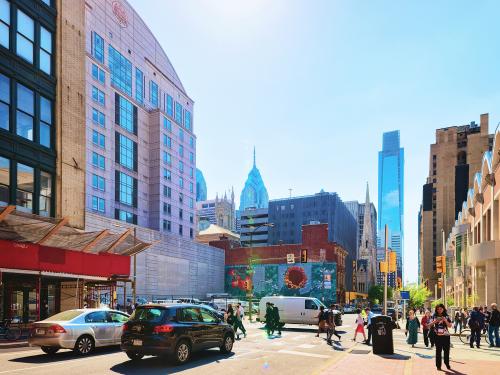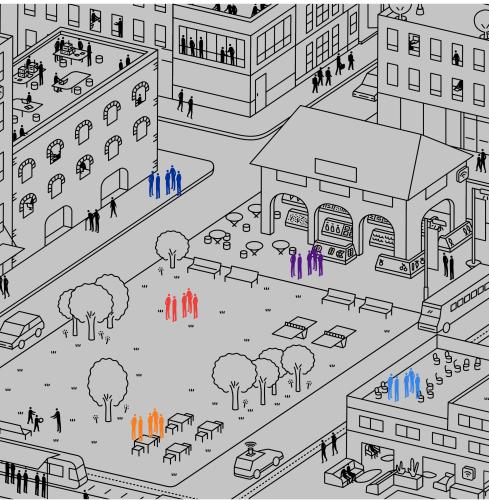In cities around the world, a growing movement is redefining the spatial geography of the innovation economy.
Innovation districts are evolving geographies of innovation anchored by R&D-intensive universities, medical institutions, and companies. Analysis now shows there are well over 100 innovation districts emerging globally in cities with vastly different economic starting points, regional advantages, and population sizes. Unlike traditional research parks and science corridors, these districts embrace the urban attributes of density, proximity, and accessibility—places where a “mash up” of economic strengths, physical assets and amenities, and robust social networks foster an open, collaborative innovation ecosystem.
The development of these districts is far from perfect. And to some researchers, innovation districts are little more than a fad: one-dimensional, self-enriching acts led by developers, university administrators, or others to artificially inflate the market. This is an oversimplification of the vast differences among these geographies and how and why they have emerged. This view also overlooks the intentional efforts of many public, private, and civic sector leaders to nurture and grow these districts—and in turn, their regional economies—in ways that benefit greater numbers of citizens.
The recently-launched Global Institute on Innovation Districts is working to highlight some of these efforts toward inclusivity. Building on several years of research and on-the-ground engagements in districts around the world, our new paper, The Evolution of Innovation Districts: The New Geography of Global Innovation, documents how a subset of districts are designing new organizational structures, programs, and place-focused investments to create a more inclusive model of growth.
Districts in the midst of deepening economic, social, and racial divides
Innovation districts are emerging at a time of dramatic economic change and of increasing economic disparities among people and places. The United States, in particular, is experiencing a growing tension around the role of innovation in driving inequality. The controversies surrounding the national competition for Amazon’s HQ2 headquarters and the rising disparities generated by the tech sector, particularly, have cast a dark shadow over innovation geographies. This includes innovation districts, in both the U.S. and abroad.
Our work acknowledges this discord. The Evolution of Innovation Districts paper describes how, in the U.S., local leaders and residents have begun to question whether innovation districts are ameliorating or exacerbating the longstanding and complex challenges around economic, social, and racial inequities. In response, the report catalogues how a subset of successful districts are advancing inclusion and social innovation strategies to guide their growth—providing examples in cities as disparate as Buffalo, N.Y.; Dublin; Linz, Austria; and Santiago, Chile.
Local innovation district leaders—which can include universities, hospitals, not-for-profits, the private sector, and local governments—are slowly inventing a practice of “inclusive innovation” to ensure that innovation economy growth advances inclusive outcomes for residents living in or nearby an innovation district. “Inclusive innovation” seeks to create pathways to labor market participation with specialized education and customized job training. It strives to build wealth via expanding the ownership of homes and businesses. And it tries to create a new model of responsible neighborhood regeneration, where improvements can occur without displacement. For example, Philadelphia shows how innovation districts can use the economic power of anchor institutions to drive job growth in areas of deprivation and catalyze the formation of community businesses, minority-owned businesses, and social enterprises.
At the same time, cities are experimenting with multiple forms of “innovative inclusion” to bring new kinds of community-led, anchor-supported, technology- and entrepreneurial-driven problem-solving to low-income communities. While leader-led “inclusive innovation” aims to share the benefits of the innovation economy more broadly among residents, community-led “innovative inclusion” empowers whole communities to address problems in new and creative ways. This approach emerged not only due to their proximity to districts, but also because districts themselves encourage hackathon-style activities and cross-disciplinary open innovation—tactical interventions that are well suited to tackling longstanding social and economic challenges.
Innovation districts are beginning to play a critical role in challenging long-standing economic and social divides.
Innovation districts are beginning to play a critical role in challenging long-standing economic and social divides. Their collective shift toward inclusivity is a necessary one, and represents a fundamental change in how we both conceptualize and create economic prosperity in the changing global economy.
A new network of innovation district leaders
The evolution of innovation districts signals a tectonic shift in how cities see themselves and value their local economic strengths, “place,” and the people that live and work there. Looking ahead, it is these districts that appear to be best positioned to push both “innovative inclusion” and “inclusive innovation” to a new level of systemic change, from the bottom up.
It is this push toward inclusion that inspired me, together with other researchers and practitioners, to create the Global Institute. Comprised of a growing network of innovation district stakeholders, this new nonprofit aims to harness the energy and ambition of local actors to leverage their research strengths, grow and expand innovative firms, and advance their regional economies in ways that yield more equitable and inclusive outcomes. In collaboration with Brookings, the Global Institute will conduct research on district challenges and successes, provide data and evidence-based strategies to accelerate district advancement, help design new norms around finance and governance, and support engagement and shared learning across districts.
While there is still more work to be done, innovation districts are showing that they can serve as global models for place-led, inclusive economic development. Through ongoing engagement and shared learning with and alongside districts, the Global Institute hopes to push this model even further—inspiring bold leadership and strategies that make the innovation economy work for all.







Commentary
New insights on how innovation districts are challenging economic and social divides
July 19, 2019